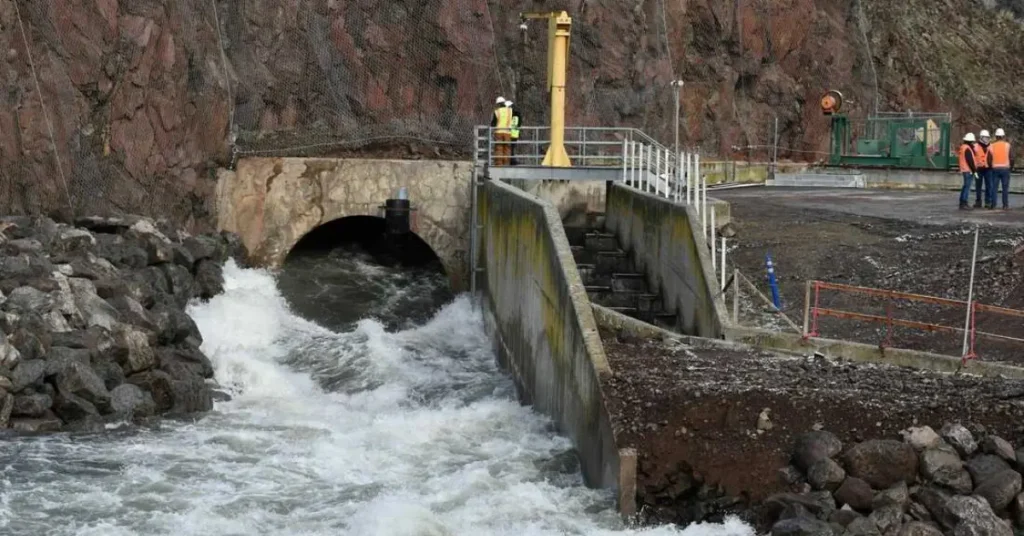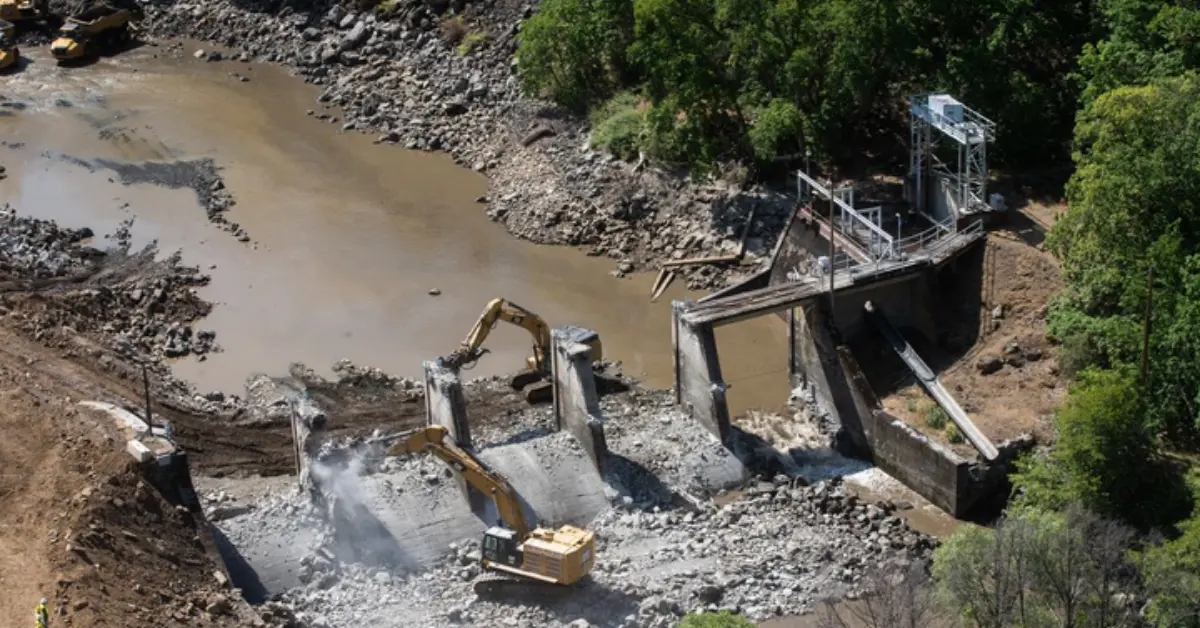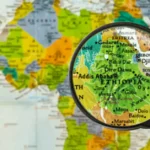Klamath River Dam Removal: Klamath River Reborn
The Klamath River, winding its way through Oregon and California, is experiencing a historic transformation. After decades of being fractured by dams, the river is finally being restored to its natural state through the largest dam removal project ever undertaken in the United States.
The Klamath River, once a vibrant artery teeming with life, faced significant challenges due to the construction of four dams on its mainstem over a century ago. These dams, while providing hydroelectric power, disrupted the natural flow of the river, impacting salmon migration, water quality, and the surrounding ecosystem. However, a historic and ambitious project is underway to restore the Klamath River to its former glory – the Klamath Dam Removal Project.
World’s biggest dam removal project changing a California river I ABC10
A River Interrupted: Legacy of the Klamath Dams
Four dams – Copco No. 1, Copco No. 2, Iron Gate, and J.C. Boyle – have significantly impacted the Klamath River since their construction in the early 20th century. While they provided hydroelectric power, their presence came at a heavy cost.
- Impact on Salmon: The dams blocked the migration of salmon and steelhead trout, hindering their access to crucial spawning grounds. These fish are integral to the Klamath ecosystem, serving as a food source for many other species and playing a vital cultural role for the Klamath Tribes.
- Ecological Disruption: The dams altered the river’s natural flow, affecting water quality, sediment transport, and overall ecosystem health.
- Cultural Impact: The dams disrupted the traditional way of life for the Klamath Tribes who have lived along the river for millennia.
Decades of Advocacy Culminate in Historic Decision
The Klamath River dam removal project is the result of decades of tireless advocacy by the Klamath Tribes, environmental organizations, and concerned citizens. They argued for the ecological and cultural restoration of the river, highlighting the negative impacts of the dams.
A crucial turning point came in 2016 when the Klamath Basin Tribes and the PacifiCorp, the dam owner, reached an historic agreement to remove the dams. This agreement paved the way for the project to proceed, receiving final approval from the Federal Energy Regulatory Commission (FERC) in 2022.

Also read: Where Is Bohemian Grove? What Is Bohemian Grove? Shocking Claim By Ryan Garcia
Klamath River Dam Removal Process: The Largest Dam Removal Project in U.S. History
The Klamath Dam Removal Project, initiated in 2023, is the largest dam removal project ever undertaken in US history. It involves meticulous planning, coordination, and collaboration between various stakeholders, including:
- Klamath Basin Tribes: The Yurok, Karuk, Klamath Tribes, and Hoopa Valley Tribe play a crucial role in the project, ensuring respect for their cultural heritage and traditional knowledge of the river.
- PacifiCorp: The former dam owner is responsible for the safe and responsible decommissioning and removal of the dams.
- Federal and State Agencies: The Federal Energy Regulatory Commission (FERC), Bureau of Reclamation, and the states of Oregon and California provide essential regulatory oversight and support for the project.
- Non-profit Organizations: Environmental organizations like American Rivers and California Trout contribute technical expertise and advocacy for the project’s success.
Removing the dams is a complex and meticulous process. It involves:
- Decommissioning power plants: This ensures the safe and responsible shutdown of the hydroelectric facilities associated with the dams.
- Lowering water levels: The water level behind the dams is gradually lowered to expose the dam structures.
- Breaching the dams: Controlled breaches are created in the dams, allowing the river to flow freely once again.
- Habitat restoration: Efforts are undertaken to restore the riverbed and surrounding habitats, promoting the return of native vegetation and fish populations.
The first dam, Copco No. 2, was successfully removed in October 2023. The removal of the remaining three dams is ongoing and is expected to be completed by the fall of 2024.
Klamath River Dam Removal – A Future of Hope: Restoration and Renewal
The Klamath dam removal project is not just about removing concrete structures; it’s about restoring a vital ecosystem and honoring the cultural heritage of the Klamath Tribes.
- Salmon Recovery: With the dams removed, salmon and steelhead trout will have access to hundreds of miles of previously inaccessible spawning grounds, offering hope for the recovery of these iconic fish populations.
- Ecological Rejuvenation: The removal of dams allows for the natural flow of the river, improving water quality, sediment transport, and overall ecological health.
- Cultural Renewal: The restored river will create opportunities for the Klamath Tribes to reconnect with their traditional way of life and cultural practices.
The Price of Restoration: Funding the Klamath Dam Removal
The Klamath Dam Removal Project, while hailed as a monumental undertaking for ecological restoration, comes with a significant price tag. The estimated cost of the project is $500 million. This substantial sum is shared by two primary contributors:
- Taxpayers: A portion of the project’s funding comes from federal and state government sources. This contribution reflects the public interest in environmental restoration and the long-term benefits the project offers to the Klamath Basin ecosystem and communities.
- PacifiCorp Ratepayers: As the former owner of the dams, PacifiCorp, a utility company, is responsible for a significant portion of the project’s cost. This contribution comes from the rates paid by the company’s customers.
It’s important to note that the cost of dam removal is weighed against the projected benefits and potential cost-savings in the long run. Here’s a breakdown of the rationale behind the project’s cost:
- Decommissioning and Removal: The careful dismantling and removal of the dams themselves require specialized equipment and expertise, contributing significantly to the cost.
- Habitat Restoration: Restoring the riverbed and surrounding areas after dam removal is crucial for the ecosystem’s recovery, adding to the project’s expense.
- Mitigation Measures: Addressing potential impacts on water quality, infrastructure, and local communities during and after removal necessitates various mitigation strategies, further contributing to the cost.
While the initial investment is substantial, the project is expected to generate long-term benefits that outweigh the cost. These benefits include:
- Improved water quality: The natural flow restoration can lead to reduced treatment costs for water users downstream.
- Enhanced fisheries: Revitalized salmon populations can contribute to a thriving commercial and recreational fishing industry, generating economic benefits.
- Increased tourism: The restored river is expected to attract more visitors for recreational activities like fishing and rafting, boosting the local economy.
Ultimately, the Klamath Dam Removal Project represents a significant investment in restoring the ecological health of the Klamath River. While the cost is substantial, the potential long-term benefits for the environment, economy, and cultural heritage of the region offer a compelling justification for this historic undertaking.
The Klamath dam removal project is a landmark undertaking with the potential to serve as a model for future dam removal efforts around the world. It’s a testament to the power of collaboration, perseverance, and the unwavering commitment to restoring the natural world and its inhabitants.
As the Klamath River flows freely once again, it carries with it the promise of a renewed future for the environment, the communities that depend on it, and the spirit of the Klamath people.
FAQs
1. What dams are being removed on the Klamath River?
The Klamath Dam Removal Project involves removing four dams on the Klamath River: Copco No. 1, Copco No. 2, Iron Gate, and J.C. Boyle. These dams were built between 1906 and 1958 for hydroelectric power generation but have since become significant barriers to fish passage and ecosystem health.
2. When is the Klamath River dam removal happening?
Copco No. 2 dam removal was completed in October 2023. The removal of the remaining three dams began in January 2024 and is expected to be completed by mid-October 2024.
3. Who is responsible for the Klamath River dam removal project?
The Klamath Dam Removal Project is a collaborative effort involving various stakeholders, including:
*Klamath Basin Tribes
*PacifiCorp (former dam owner)
*Federal and State Agencies (FERC, Bureau of Reclamation, Oregon & California)
*Non-profit Organizations (American Rivers, California Trout)
4. Why are they removing the dams on the Klamath River?
The dams have had a significant negative impact on the Klamath River ecosystem, primarily by:
*Blocking salmon migration
*Degrading water quality
*Disrupting the natural flow and sediment transport
Removing the dams aims to restore the river’s health, allowing salmon populations to recover and the ecosystem to thrive.
5. How much does the Klamath River Dam Removal Project cost?
The Klamath Dam Removal Project is estimated to cost $500 million.
6. Who pays for the Klamath River Dam Removal Project?
The cost is shared by taxpayers and PacifiCorp ratepayers.
Content Contributor: Rehana Sengupta









